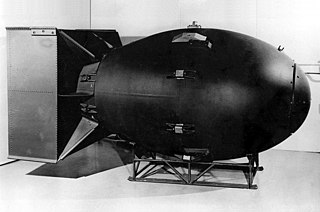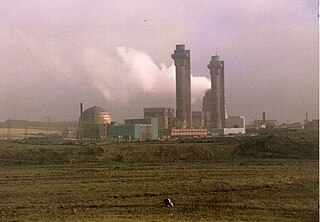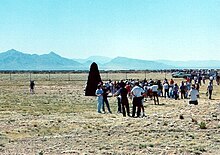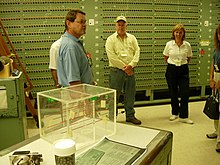
"Fat Man" was the codename for the type of nuclear weapon the United States detonated over the Japanese city of Nagasaki on 9 August 1945. It was the second of the only two nuclear weapons ever used in warfare, the first being Little Boy, and its detonation marked the third nuclear explosion in history. It was built by scientists and engineers at Los Alamos Laboratory using plutonium from the Hanford Site, and one was dropped from the Boeing B-29 Superfortress Bockscar piloted by Major Charles Sweeney.

Little Boy was the name of the type of atomic bomb used in the bombing of the Japanese city of Hiroshima on 6 August 1945 during World War II, making it the first nuclear weapon used in warfare. The bomb was dropped by the Boeing B-29 Superfortress Enola Gay piloted by Colonel Paul W. Tibbets Jr., commander of the 509th Composite Group, and Captain Robert A. Lewis. It exploded with an energy of approximately 15 kilotons of TNT (63 TJ) and had an explosion radius of approximately 1.3 kilometers which caused widespread death across the city. The Hiroshima bombing was the second nuclear explosion in history, after the Trinity nuclear test.

Trinity was the code name of the first detonation of a nuclear weapon, conducted by the United States Army at 5:29 a.m. MWT on July 16, 1945, as part of the Manhattan Project. The test was of an implosion-design plutonium bomb, nicknamed the "gadget", of the same design as the Fat Man bomb later detonated over Nagasaki, Japan, on August 9, 1945. Concerns about whether the complex Fat Man design would work led to a decision to conduct the first nuclear test. The code name "Trinity" was assigned by J. Robert Oppenheimer, the director of the Los Alamos Laboratory, inspired by the poetry of John Donne.

The Nevada National Security Sites, popularized as the Nevada Test Site (NTS) until 2010, is a reservation of the United States Department of Energy located in the southeastern portion of Nye County, Nevada, about 65 mi (105 km) northwest of the city of Las Vegas.

The Atomic Age, also known as the Atomic Era, is the period of history following the detonation of the first nuclear weapon, The Gadget at the Trinity test in New Mexico, on 16 July 1945, during World War II. Although nuclear chain reactions had been hypothesized in 1933 and the first artificial self-sustaining nuclear chain reaction had taken place in December 1942, the Trinity test and the ensuing bombings of Hiroshima and Nagasaki that ended World War II represented the first large-scale use of nuclear technology and ushered in profound changes in sociopolitical thinking and the course of technological development.

Building on major scientific breakthroughs made during the 1930s, the United Kingdom began the world's first nuclear weapons research project, codenamed Tube Alloys, in 1941, during World War II. The United States, in collaboration with the United Kingdom, initiated the Manhattan Project the following year to build a weapon using nuclear fission. The project also involved Canada. In August 1945, the atomic bombings of Hiroshima and Nagasaki were conducted by the United States, with British consent, against Japan at the close of that war, standing to date as the only use of nuclear weapons in hostilities.

A nuclear and radiation accident is defined by the International Atomic Energy Agency (IAEA) as "an event that has led to significant consequences to people, the environment or the facility." Examples include lethal effects to individuals, large radioactivity release to the environment, or a reactor core melt. The prime example of a "major nuclear accident" is one in which a reactor core is damaged and significant amounts of radioactive isotopes are released, such as in the Chernobyl disaster in 1986 and Fukushima nuclear disaster in 2011.

The Windscale fire of 10 October 1957 was the worst nuclear accident in the United Kingdom's history, and one of the worst in the world, ranked in severity at level 5 out of 7 on the International Nuclear Event Scale. The fire was in Unit 1 of the two-pile Windscale site on the north-west coast of England in Cumberland. The two graphite-moderated reactors, referred to at the time as "piles," had been built as part of the British post-war atomic bomb project. Windscale Pile No. 1 was operational in October 1950, followed by Pile No. 2 in June 1951.

Lake Karachay, sometimes spelled Karachai or Karachaj, was a small lake in the southern Ural mountains in central Russia. Starting in 1951, the Soviet Union used Karachay as a dumping site for radioactive waste from Mayak, the nearby nuclear waste storage and reprocessing facility, located near the town of Ozyorsk. Today the lake is completely infilled, acting as "a near-surface permanent and dry nuclear waste storage facility."

The Nagasaki Atomic Bomb Museum is in the city of Nagasaki, Japan. The museum is a remembrance to the atomic bombing of Nagasaki by the United States on 9 August 1945 at 11:02:35 am. Next to the museum is the Nagasaki National Peace Memorial Hall for the Atomic Bomb Victims, built in 2003. The bombing marked a new era in war, making Nagasaki a symbolic location for a memorial. The counterpart in Hiroshima is the Hiroshima Peace Memorial Museum. These locations symbolize the nuclear age, remind visitors of the vast destruction and indiscriminate death caused by nuclear weapons, and signify a commitment to peace.

This article compares the radioactivity release and decay from the Chernobyl disaster with various other events which involved a release of uncontrolled radioactivity.

The National Museum of Nuclear Science & History is a national repository of nuclear science information chartered by the 102nd United States Congress under Public Law 102-190, and located in unincorporated Bernalillo County, New Mexico, with an Albuquerque postal address. It is adjacent to both the Albuquerque city limits and Kirtland Air Force Base.

Anti-nuclear protests began on a small scale in the U.S. as early as 1946 in response to Operation Crossroads. Large scale anti-nuclear protests first emerged in the mid-1950s in Japan in the wake of the March 1954 Lucky Dragon Incident. August 1955 saw the first meeting of the World Conference against Atomic and Hydrogen Bombs, which had around 3,000 participants from Japan and other nations. Protests began in Britain in the late 1950s and early 1960s. In the United Kingdom, the first Aldermaston March, organised by the Campaign for Nuclear Disarmament, took place in 1958. In 1961, at the height of the Cold War, about 50,000 women brought together by Women Strike for Peace marched in 60 cities in the United States to demonstrate against nuclear weapons. In 1964, Peace Marches in several Australian capital cities featured "Ban the Bomb" placards.
The Neutron Trail is an open cultural dialogue into our shared nuclear legacy intended to raise awareness and stimulate strategic thinking around nuclear power and nuclear disarmament. Neutron Trail deals with paradoxical human dilemmas, such as the world's need for large outputs of energy amid ongoing and often charged discussions regarding sustainability, and pervasive public fears surrounding nuclear energy. Through visiting the people and places most impacted by society's nuclear legacy, transmedia projects, public lectures and workshops, the Neutron Trail works to engage people from all walks of life in an ongoing exploration and evaluation of existing perceptions — true and untrue — about nuclear energy and weapons.

Nuclear labor issues exist within the international nuclear power industry and the nuclear weapons production sector worldwide, impacting upon the lives and health of laborers, itinerant workers and their families.

High Explosive Research (HER) was the British project to develop atomic bombs independently after the Second World War. This decision was taken by a cabinet sub-committee on 8 January 1947, in response to apprehension of an American return to isolationism, fears that Britain might lose its great power status, and the actions by the United States to withdraw unilaterally from sharing of nuclear technology under the 1943 Quebec Agreement. The decision was publicly announced in the House of Commons on 12 May 1948.





















